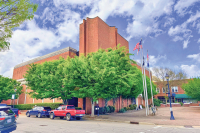Saving the language: Teachers, parents, tribal elders and new innovative immersion programs are helping to keep the Cherokee language alive
By Michael Beadle
It’s a special day for 14-month-old Tawodi Clapsaddle.
Several adults including his father, Ethan, look on as the curious toddler explores tiny furniture and grabs a hold of toys in his new classroom at the Dora Reed Tribal Childcare center in Cherokee.
You won’t hear his teachers speaking English.
That’s because Tawodi is part of a language immersion program that introduces children to an all-Cherokee language environment before they begin talking.
With a growing interest among parents and tribal leaders to honor and preserve the Cherokee language, the Dora Reed Tribal Childcare center opened its second Cherokee immersion classroom in January. The first room opened in April 2004. Since small student-teacher ratios offer more one-on-one attention, the classes have a maximum of eight children. Tawodi was one the first to join this second classroom at the center.
Known as the Tsu-Ni-S-Di Tsa-La-Gi U-Na-De-Lo-Qua-S-Di, or the “place for babies to learn Cherokee,” the room looks like any other childcare classroom, and teachers adhere to all the federal and state standards of a day care center. But instead of alphabet letters and word labels written in English, the Cherokee syllabary is displayed and toy blocks have Cherokee symbols printed colorfully. Stuffed animals in the room are the animals of traditional Cherokee culture — bear, deer, raccoon, beaver, bobcat, possum, eagle and squirrel. Labels on the walls are written in Cherokee, and the teachers speak in Cherokee when interacting with the children.
“We’re really excited about it,” says Ethan Clapsaddle.
Once parents enroll their child in the Cherokee immersion class, they also take Cherokee language classes themselves in order to reinforce their child’s language skills. Clapsaddle says he and Tawodi’s grandparents will be taking these classes at least once a week.
“We know the [names of] foods or things like that,” he says. “And he [Tawodi] knows — he knows what it means.”
“Kena,” Ethan says to Tawodi, meaning “Come here.”
The teachers in the classroom — Sharyn Panther and Stacy Wolfe West — greet Tawodi with warm smiles.
“Siya,” Panther says, meaning “Hello.”
Though Tawodi hasn’t begun speaking in sentences yet, he’ll pick up the meaning of Cherokee words through gestures, non-verbal cues and repetition of words he hears in the immersion class. The idea is to give him enough familiarity with the language so he’ll feel comfortable using Cherokee when he begins to speak regularly. Whatever Tawodi picks up in his hands, the teachers will be ready to identify it in Cherokee.
With two special Cherokee immersion classrooms at the Dora Reed Tribal Childcare center, it’s not only a challenge to find classroom space. It’s also difficult finding Cherokee speakers who are fully certified in child development training. And because the Dora Reed center receives funding for Head Start, the center must adhere to strict federal standards as well.
But the challenges are worth it for Renissa Walker, the culture and language program manager for the Eastern Band of Cherokee Indians. Walker is helping to preserve the Cherokee language on the Qualla Boundary and eventually for schools around Western North Carolina that have significant Cherokee student populations.
“We don’t want the burden of language survival to be based on only eight children,” Walker said.
The Cherokee immersion program came out of months of planning, working with parents, and researching other successful native language immersion programs, Walker explained.
“We’re thrilled that this has become a reality,” said Frances Maney, director of Cherokee Tribal Childcare programs that oversees the immersion classes.
Parents are already being waitlisted to get their children enrolled in the program.
“We’ll probably fill that classroom up fairly quickly,” Maney said of the newest immersion class. “A big part of it has been word of mouth.”
For Maney, who grew up in a family where Cherokee was spoken regularly, the Cherokee language was not viewed as a foreign language as it is to many Cherokee children growing up today. According to an estimate from the National Endowment for the Humanities, which is helping to preserve Native American languages, there are only about 10,000 Cherokee speakers in Oklahoma and North Carolina and many of these are more than 50 years old.
Picking up Cherokee language skills is a lot harder when you’re not familiar with the language. Stacy Wolfe West, one of the teachers in the Dora Reed Center’s Cherokee immersion class, realized this when she was teaching Cherokee in the elementary school for four years.
“I had some good students when I was down there,” West said. But, she added, it was frustrating teaching students who didn’t want to learn the language. “Because when I was down there, you could tell you needed to start earlier than that.”
That’s why West came to the Dora Reed center: to give even younger children more exposure to the language. That way, when they get to elementary school, they’ll already have experience with speaking and recognizing the language.
Preserving the language runs in the family. West’s brother, Jonah Wolfe, teaches Cherokee language classes at Cherokee Middle School.
So were there immersion classes when West was growing up?
“No, I didn’t need it,” she said. “It was my first language.”
Forbidden words
Last May, at a two-day symposium in Cherokee on language preservation, local Cherokee leaders and nationally recognized language experts came together to discuss the future of the Cherokee language.
Harry Oosahwee, language project supervisor for the Cherokee Nation of Oklahoma, addressed the participants at the symposium with a stark observation: “The Cherokee language won’t be around if we don’t do something about it.
“We are the warriors that are going to teach the language,” he continued. “It’s not your fault you don’t know the language. It is your fault if you don’t learn it.”
Another speaker at the symposium, Akira Yamamoto, a world-renowned linguist and consultant for the Cherokee Nation in Oklahoma (where Cherokee immersion classes are also under way), noted that 90 percent of the world’s 6,818 languages would disappear by the end of this century.
Armed with this sense of urgency, Cherokee tribal leaders and language experts are making sure the Cherokee language is more accessible to the younger generation of Cherokees. There are more public street and building signs posted with Cherokee symbols, and the newly opened Fine and Performing Arts Center at Western Carolina University features huge welcoming signs carved with Cherokee syllables.
In addition to the Dora Reed day care’s immersion programs, the Cherokee school system is building an immersion program in the elementary school that will eventually encompass all grades. High school students now take Cherokee language classes as graduation requirements.
Honoring the language also means remembering the scars of its history. Donna Beck, a fourth-grade teacher at Cherokee Elementary School, compiled a comprehensive unit plan for students to learn the history of how the Cherokee language was almost lost forever. (The Web site is at aam.wcu.edu/beck/.)
Back in the late 19th century, boarding schools sprung up on Indian reservations across the United States in an effort to quash cultural differences between Native Americans and white Americans. “Kill the Indian and save the man,” was the mantra from Capt. Richard Henry Pratt, who began the first such boarding school in Pennsylvania, the Carlisle School, founded in 1879.
Many Indian children were forcibly removed from their homes and placed in boarding schools where they lived by a strict daily schedule that included military marching, English reading and writing lessons, vocational classes, and a philosophy that Native American culture was somehow wrong and should be forgotten. The belief behind this movement was that Native Americans should be assimilated into an Anglicized, Christian society. Therefore, Native languages were forbidden, traditional names were replaced with Christian ones, and Native clothing was replaced with pants and shirts that were deemed “more civilized.” Cherokee boarding school students were physically punished for writing or speaking in their own native language while at school.
With the educational reforms of the mid-1900s came more opportunities to preserve Cherokee customs, language and traditional arts and crafts. Now, Cherokee youth are gaining more opportunities than ever to learn the Cherokee language in schools and preserve their culture for generations to come.
As part of a multi-year project with the National Endowment for the Humanities and the National Science Foundation, the Museum of the Cherokee Indian is creating a digital version of the Cherokee syllabary to be used for translations and studies. This, along with audio recordings of Cherokee elders, will be collected and made accessible online and at the Cherokee museum and the Smithsonian National Anthropological Archives in Maryland.
Shi-gwo
At Cherokee Elementary School, the morning announcements, the Pledge of Allegiance and the happy birthday song are spoken in Cherokee, and both students and teachers have daily Cherokee language activities. Students celebrate traditional Cherokee songs and dances, and some of the teachers get together after school on Thursdays to learn and sing Cherokee songs.
All students at Cherokee Elementary get at least 10 minutes of Cherokee language instruction each day with kindergarten students getting 15 to 20 minutes of instruction and students in grades 1 through 3 getting a Cherokee language class for 35 minutes. On top of that, there is a Cherokee immersion class where students speak and write only in Cherokee. The immersion classes in grades kindergarten through fourth grade meet for 35 minutes each day.
“We’ve noticed a big change in the kids,” said Lucetta Ward, who teaches Cherokee language classes at Cherokee Elementary.
Students regularly get asked to go out into the community to sing or recite Cherokee for sports events and civic meetings. Once Cherokee children were ashamed to speak their native language, and now it is a badge of honor. And even if the students don’t always get the correct pronunciation or use the correct words in Cherokee, Ward encourages her students for simply trying.
“If you make a mistake, it’s OK,” Ward said. “If you speak it, we will reward it.”
Growing up bilingual (speaking Cherokee and English) Ward wasn’t always comfortable speaking in her native language.
“The other kids looked at you funny — they treated you different,” she said.
So Ward makes every effort to ease children into the Cherokee language by getting them familiar with phrases and words. When she sees students outside of class or in Wal-Mart, she’ll ask them questions in Cherokee, and they’ll respond in Cherokee.
Like learning anything, there’s a lot of practice involved, so students become familiar with the word “shi-gwo,” meaning “again.”
Far from the days of the boarding schools, teachers and staff at Cherokee schools are now required to incorporate Cherokee culture and language into the class lessons, according to federal mandates. But it’s hard trying to find Cherokee teachers, says Ward, who has been teaching for 14 years.
“Not every speaker is a teacher,” she explained.
Each year, the students from the Cherokee immersion program will move up a grade and take the immersion program one more step until it eventually becomes a kindergarten-through-12th grade program. When the new elementary, middle and high schools are built on the same campus, Cherokee language teachers will be located closer together, and the goal is to have a more cohesive plan for coordinating the language curriculum.
Since there aren’t yet textbooks with Cherokee language activities, the elementary school’s teachers and their counterparts at Cherokee middle and high schools have been gradually compiling lesson plans, worksheets and materials to build the curriculum.
It’s also a challenge trying to adhere to No Child Left Behind mandates, Bureau of Indian Affairs’ standards, and local school system guidelines — all while allowing for a relatively new program to grow and evolve.
“It’s a work in progress, but it’s getting better,” said Cherokee Elementary Principal Charles Easton.





